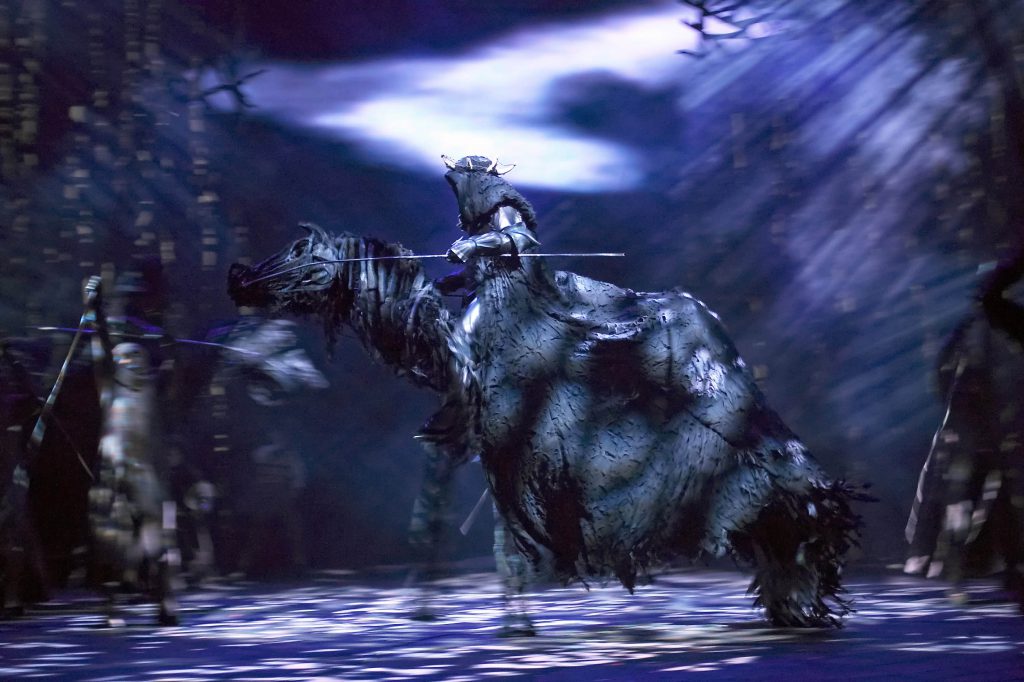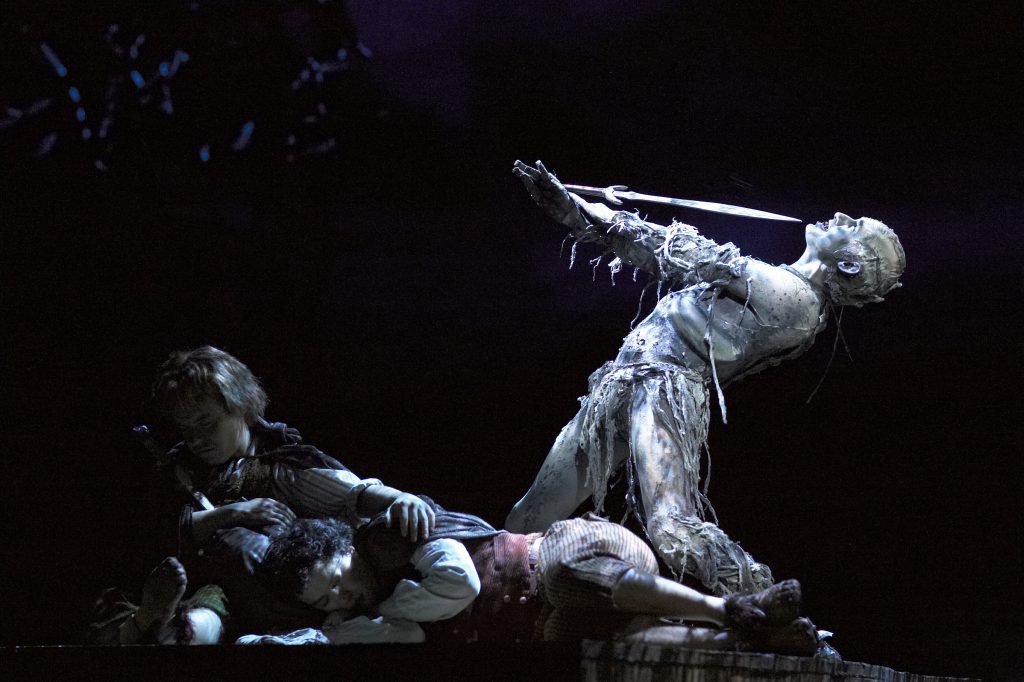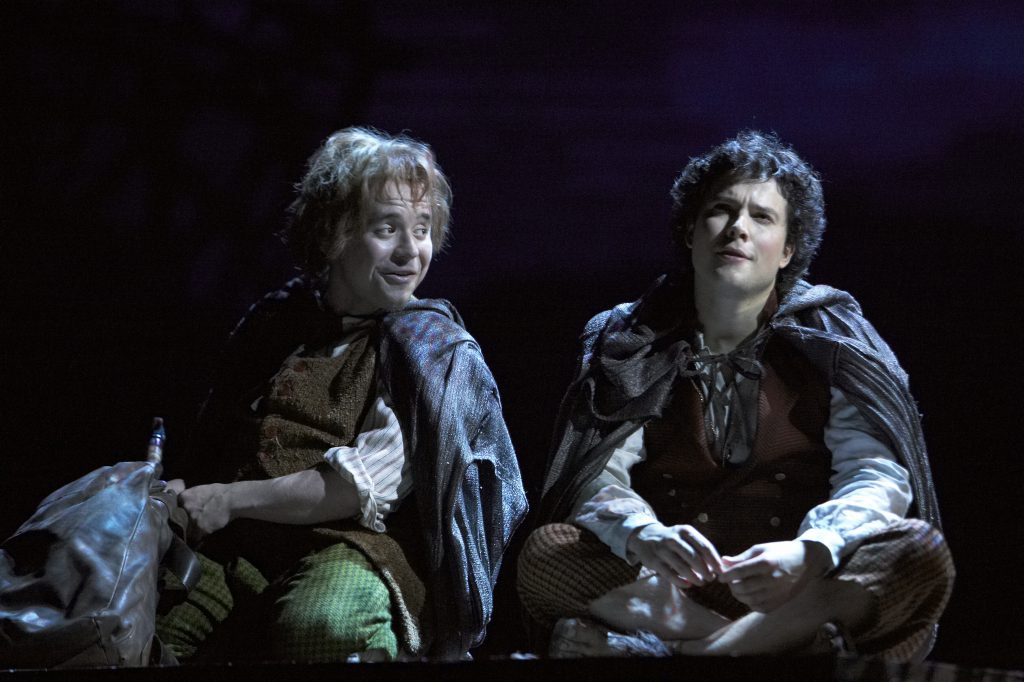Paul Pyant: Balanced Light
Posted on December 4, 2018
Photo: Manuel Harlan
When discussing his acclaimed work in Charlie and the Chocolate Factory with us, this Olivier Award winner jokingly referred to himself as a “Darkness Designer.” Indeed, it would have been impossible for anyone who saw Pyant’s lighting design for the 2013 Sam Mendes-directed musical not to marvel at how he wielded dark space like some giant magnifying device to make the bright colors of the play’s costumes and scenic elements pop with a larger-than-life radiance. It was a feat that he had also accomplished five years earlier, albeit with distinctly more menacing hues, in the London première of Lord of the Rings.
For Pyant, though, it was not so much the darkness as it was the interplay between those areas that were lighted and those that weren’t that made these designs work. Balancing divergent elements, be they darkness and light, white light and color, or the visions of a director and scenic designer, has been at the heart of this British-born LD’s creative vision throughout his prolific and celebrated career in opera and theatre.
Widely praised by critics and his peers for the harmonious beauty of his work, Pyant has been nominated multiple times for Tony Awards, in addition to winning Olivier and Critics’ Circle Awards. He has designed for opera internationally, as well as for theatrical productions on the West End and Broadway. Speaking to us during production week of The Price at the Theatre Royal, Bath, he shared his insights into the aesthetic balance of lighting design.

Photo: Theatre Royal Drury Lane
In your 2013 Olivier Award-winning lighting design for Charlie and the Chocolate Factory, you made wonderfully effective use of contrasts, often having some characters in light, while keeping others in semi-darkness. What are your thoughts on creating contrasting areas of light and relative darkness on stage?
“Sometimes I think I should be re-christened ‘Darkness Designer!’ In many designs, the darkness on a stage is as important as the light. Nothing is more exciting than to be in a totally black space that can be transformed by the addition of even minimal light and haze into one of infinite possibilities. Charlie was a true gift of a design to work in. There is a dark quality to the story, which Sam Mendes and Mark Thompson wanted to accentuate in some scenes, whilst always keeping in mind the narrative and focus on what an audience has to understand about action for the story. Also, on Charlie we worked closely with Jon Driscoll, the projection designer, and he was able to provide highly detailed textures projected over the set elements, which gave terrific extra dimension to some scenes.”
We talked about darkness, now let’ s discuss light. How important are focus, color, white light?
“All important, of course. Each lighting angle, every color is crucial to the creation of a stage picture. With the right focus and color, you can eloquently suggest time of day, the weather, the temperature, or the style of production. It is critical in supporting what the actors are doing in making sense of the drama.”
If you were at a party and someone asked you, ‘What is the role of lighting in a theatrical production?’ what would you say?
“Simply that I am there to help provide the right ambience, which makes the story be told as clearly as possible or dramatic as needed. Lighting can be the glue that holds everything together or oil that smooths the experience.”

Photo: Theatre Royal Drury Lane
Do you have to like a play to do a good job lighting it?
“It helps, I suppose. One of the strange things about being a lighting designer is that you are in the unique position of being able to do what you do only in a theatre. You sit there over the years watching/listening — it’s a process that can go several ways. Some days you are totally convinced by what the writer/composer/director/actors are doing. At those times, it’s a privilege to see them at the top of their craft working well, especially in a dull rehearsal room on a rainy Monday morning. On the other hand, it can also be very difficult to sit there and watch it all going pear shaped. However, one shouldn’t judge too early in the process. My job is to support and bolster the process, and help in any way I can to achieve the best results.”
You’ve been very prolific. How do you keep your approach to lighting design fresh? How do you get inspired?
“Not sure about prolific — I have been lucky enough to keep being busily employed for over 40 or so years. In the UK, you need to do a minimum 12-15 projects a year to make a decent income, unless you are lucky enough to have a commercial success that pays a reasonable royalty! I am very much a creative team-led lighting designer. In other words, I am there to support the concepts of others. I obviously now have directors and designers I trust and enjoy working with, and who know what I can bring to the table without imposing anything on the production that is not suitable. I also try to mix in a new director or designer occasionally when it seems a good idea and I am up for the challenge! I hope that my approach is always fresh. I try hard to keep it so. I like to get involved on a show as early as possible, so I can influence details that would improve opportunities.”
How do you get inspired?
“Inspiration is harder to quantify. It’s hard sometimes when staring at a blank drawing board in my office (YES, I still draft by hand) at midnight listening to the sound of deadlines as they swish past. I certainly do not automatically know all the answers, even now. I suppose if I’m stuck I tend to fall back on techniques I know work. Maybe, if the budget allows, I can add the odd ‘wild card’ piece of equipment to the familiar technique on a hunch. It mainly works out in the end. It’s amazing to be a part of it all on those occasions when everything comes together and the chemistry is just right.”

Photo: Theatre Royal Drury Lane
At what stage in the design process do you develop your lighting plot?
“A lighting plot is a schematic drawing of what lighting equipment goes where to achieve the ‘looks’ or atmospheres that you want to achieve to complement the action. Working out what is needed is a long process that involves understanding the needs of the play and what the director and designer are trying to achieve in their planned production. My brief is to balance what they wish to achieve to the available funds, manpower, equipment and venue. Initial talks take place well before the first rehearsals. The designer produces a scale model and we have discussions.”
You’ve worked with a lot of famous directors. Do you approach design differently depending on the director?
“I have been very, very lucky to hang on the coattails of some famous directors who have given me great opportunities. Most introductions were from working on opera productions at Glyndebourne as a production electrician responsible for either programming productions or relighting productions for the touring opera. Lucky also to work with them at most of the major UK houses at times of great artistic invention.
“In many ways, I do approach projects with these directors/designers in a way that they like to work. The one thing they all had in common was they were all usually inspired in their choices of production, design and casting — and they expected that you could rise to the occasion too.”
How did you get started in lighting?
“I did not set out particularly to be a lighting designer. It was a process of curious happenstance over a number of years. I attended the Stage Management course at the Royal Academy of Dramatic Art (RADA) in London, graduating in 1973. The course then included insights into all areas of theatre production, and I found I had an affinity with the lighting side of things.
“I left RADA, and my first job (by a series of odd events) was with Glyndebourne Festival Opera as a production electrician in the lighting department. I was at Glyndebourne for 13 seasons, working my way up the ladder, first relighting productions on tour before designing lighting for them in my own right. I also spent several years between each Glyndebourne season as Company Stage Manager for Kent Opera. (Mark Henderson and Gerry Amies were the electrics team.) I picked up lighting design jobs as and when I could. I think my first paid lighting job (£25!) was for an opera production at the French Institute in London. I did not go fully freelance as a lighting designer until 1987.”

Photo: Nobby Clark
Who were the most influential people in your career?
“Life is a continual process of learning. I find things out when working with all sorts of people. I would have to say the most influential were Dorothy Tenham (Director of SM training) and Douglas Heap (head of design), along with Francis Reid, all at RADA when I was a student. Then there is Robert Bryan, of course, who was Head of Lighting at Glyndebourne when I started. Nick Hytner took me onboard at a very early stage and gave me my first major opportunity to light at the Brighton Festival, Kent Opera, ENO, Royal Exchange in Manchester and the National Theatre. There were also designers Like Maria Bjornson and Stephan Lazaridis, as well as my partner, the director Stephen Lawless, who always supported me through those periods of doubt and worry.”
What was your first experience of theatre?
“I came from a big family and grew up during the 1950s in a pre-television era when you made your own entertainment. All my family were musical and played instruments or sang. My father was an avid amateur singer and was very active in the local Amateur Dramatic and Operatic Societies. I joined in, first onstage, then I got interested in the backstage work at a very early age. Going to the pantomime was popular at Christmas, and we went to the local theatre regularly. Masters at my school were also very keen on theatre and music, and the school mounted very sophisticated productions. Some classmates and I grouped together and formed our own theatre group, which also did productions. I was also a member of the Croydon Youth Theatre Organization. The first West End show I remember seeing was the original production of My Fair Lady at Drury Lane in 1958/9.”
You’ve worked on quite a few comedies, most recently Hay Fever. Does lighting a comedy require a different approach (or different looks) than lighting a musical or drama?
“I would say so, yes. The old adage ‘You can’t do comedy in the dark’ holds true ……keeping it light and witty….keeping colors light and faces glowing.”

Photo: Nobby Clark
You’ve also done quite a bit of work in opera. How does that differ from other theatrical projects?
“Opera is my first love. I am a huge fan. I like the grander, broader strokes commensurate to the scale of the piece we are doing. There are obvious different approaches to the grand epics of a Wagner or Verdi, compared to the intimate pieces by a Mozart or Britten. Scale is the main difference between opera and other theatrical works.
“Preparation is also paramount, as in the UK you will be working within the repertory rigs in the opera houses here. At the ROH you only really get the one technical Sunday to get as much done as possible. The rest will be lighting over the onstage rehearsals. It does pay to do as much pre-visualization as possible in the studio, as there is not a great deal of time on that one Sunday.
“A lot of opera houses around the world practice ‘Stagioni’ systems (one opera at a time), and there you get a lot more freedom to hang what you want in the air rather than an established ‘rep’ rig. The schedules of opera tend to be a drawn-out process, since, as with ballet dancers, singers can only be expected to work a couple of sessions a day.”
What are the three personality traits that you need to be a successful theatrical lighting designer?
“I would say……. Patience……Level Headedness….Humor.”
You lit some incredible scenic elements for Lord of the Rings, and earned an Olivier nomination for it. What was that project like? Any advice on lighting scenic elements?
“The Lord of the Rings was another really inspired design (Rob Howell). Bear in mind that even with all the various lifts and revolves, it basically was a blank empty space that had to become all sorts of different locations. The programming and capabilities of those lifts and revolves was amazing. They allowed the landscapes to morph seamlessly from one format to another. We were able to create many memorable images throughout that production with the help of a lot of moving heads, dense custom gobo textures that were all in motion, and the incredible work of the projection and smoke/atmosphere designers. I was particularly proud of the visual side of this project and the work of the incredible teams in Toronto and London.”
Looking at your body of work, how would you define your approach to lighting design?
“My aim for each lighting design I produce is to try and realize lighting ‘states’ or ‘looks’ to support the vision the director and set designer have for the show.”
Your work in Waiting For Godot was called “lyrical.” What made that project special?
“Once again it was basically the chemistry of all the elements coming together: a good design (Stephen Brimston Lewis), direction, and of course great performers, particularly Ian McKellen. It’s an abstract piece with a sense of both the intimate and the epic.”
You’ve worked at some great theatres; do you have a favorite?
“Opera house-wise, my spiritual home remains Glyndebourne — even the new house – but the theatre that still gives me the greatest frisson is the Royal Opera House, Covent Garden. Theatre-wise, I have always enjoyed the National Theatre venues, especially the Cottesloe (now Dorfman) in the West End, and the Theatre Royal Haymarket. In the Provinces, I would say Bath Theatre Royal……and the Royal Exchange in Manchester.”
How would you like to be remembered as a lighting designer?
“As a good colleague with a sympathetic nature who helped build and took pleasure creating some memorable theatre over a long career.”